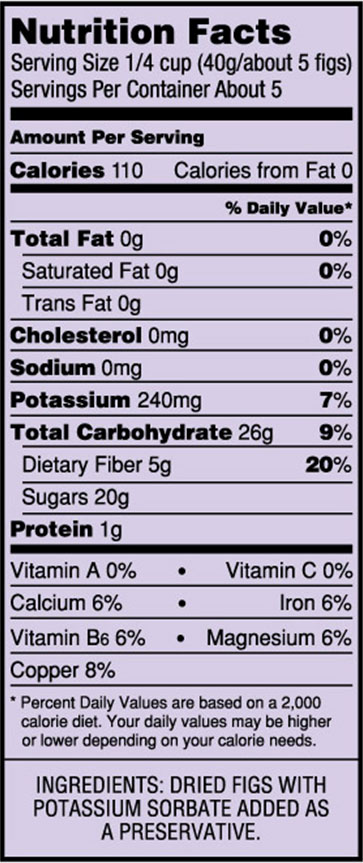Nutrition Facts
Figs: Nature’s Sweet-Tasting Nutrition Powerhouse
Indians currently consume too much sodium and too many calories from solid fats, added sugars, and refined grains. These replace nutrient-rich foods like figs and make it difficult for people to achieve recommended nutrient intakes while controlling calorie and sodium intake.
A healthy eating plan limits intake of sodium, solid fats, added sugars, and refined grains and emphasizes nutrient-rich foods and beverages—fruits, vegetables, whole grains, fat-free or low-fat milk and milk products, seafood, lean meats and poultry, eggs, beans and peas, and nuts and seeds. Indians do not get enough calcium, vitamin D, potassium and dietary fiber.
The nutrition facts panel is packed with information. Find out more about the key nutrients figs provide.
Serving Size
This section indicates how “big” the serving is and how many figs there are in a serving. The FDA determines the standard serving size for dried fruit and that is one-quarter cup (40g). Serving sizes are also given in familiar measurements, such as “pieces.”
There are several sizes of figs, so the number of “pieces” or figs in one-quarter cup varies. Dark purple BT Figs tend to be smaller than golden Deanna Figs. There are about five BT Figs in a serving. Deanna Figs tend to be larger than BT Figs so there are about three Deanna figs in a serving. Remember: All of the nutrition information on the label is based upon one serving of figs.
Percent Daily Value
This section tells you how the nutrients in one serving of figs contribute to your total daily diet. Use it to choose foods like figs that are high in the nutrients you should get more of, and low in the nutrients you should get less of.
The percent daily value can help you determine if a food is high or low in a nutrient: 5% or less is low, 20% or more is high. Daily Values are based on a 2,000-calorie diet. However, your nutritional needs will likely depend on how physically active you are. Talk to your healthcare provider to see what calorie level is right for you.
Total Fat, Saturated Fat, Trans Fat Cholesterol and Sodium
Eating too much total fat, especially saturated fat and trans fat, cholesterol, or sodium may increase your risk of certain chronic diseases, such as heart disease some cancers, or high blood pressure.
Figs naturally do not contain any fat, cholesterol or sodium making them ideal for a healthy diet.
Get Enough of these Nutrients
Indians often don’t get enough dietary fiber, vitamin A, vitamin C, calcium and potassium in their diets. These nutrients are essential for keeping you feeling strong and healthy. Eating enough of these nutrients may improve your health and help reduce the risk of some diseases.
Figs are a great source of dietary fiber and provide potassium and calcium.
Dietary Fiber Read More
Fiber is a “nutrient to get more of.” In addition to aiding in digestion, fiber has a number of other health-related benefits.
These benefits are especially effective when you have a high fiber diet that is also low in saturated fat, cholesterol, trans fat, added sugars, salt, and alcohol. Figs are a high source of fiber and contain both soluble and insoluble fiber.
- Eating a diet that is low in saturated fat and cholesterol and high in fruits, vegetables, and grain products that contain some types of dietary fiber, particularly soluble fiber, may help lower your cholesterol and reduce your chances of getting heart disease, a disease associated with many factors.
- Healthful diets that are low in fat and rich in fruits and vegetables that contain fiber may reduce the risk of some types of cancer, including colon cancer, a disease associated with many factors. In addition, such healthful diets are also associated with a reduced risk of type 2 diabetes.
- Fiber also aids in the regularity of bowel movements and preventing constipation. It may help reduce the risk of diverticulosis, a common condition in which small pouches form in the colon wall. This condition often has few or no symptoms; people who already have diverticulosis and do have symptoms often find that increased fiber consumption can reduce these symptoms.
Calcium
Calcium is a mineral that has a lot of uses in the body, but it is best known for its role in building healthy bones and teeth.
Lack of calcium causes osteoporosis, which is the primary cause of hip fractures. It’s extremely important (especially for women) to get enough calcium throughout your life, especially after menopause. Women are at much higher risk for osteoporosis, but men can get it too.
It’s true that many dairy products, which contain high levels of calcium, are relatively high in fat and calories. But keep in mind that fat-free or low-fat types of milk products are excellent calcium sources. Nutritionists recommend that you try to get most of your calcium from foods, rather than from calcium supplements.
Potassium
Potassium is a very important mineral to the human body. It has various roles in metabolism and body functions and is essential for the proper function of all cells, tissues, and organs:
- It assists in protein synthesis from amino acids and in carbohydrate metabolism.
- It is necessary for the building of muscle and for normal body growth.
- It is essential for the normal electrical activity of the heart.
Boost your potassium intake by choosing foods with potassium, which may help to lower your blood pressure. Potassium is found in fruits and vegetables, such as figs, potatoes, beet greens, tomato juice and sauce, sweet potatoes, beans (white, lima, kidney), and bananas.
Sugars
No daily reference value has been established for sugars because no recommendations have been made for the total amount to eat in a day. Keep in mind, the sugars listed on the Nutrition Facts label include naturally occurring sugars (like those in fruit and milk) as well as those added to a food or drink. Check the ingredient list for specifics on added sugars. You will see that figs are naturally sweet and do not contain any added sugars.
Iron
Iron is a mineral that our bodies need for many functions. The body needs iron to make the proteins hemoglobin and myoglobin. Hemoglobin is found in red blood cells and myoglobin is found in muscles. They help carry and store oxygen in the body. Iron is also part of many other proteins and enzymes in the body.
Your body needs the right amount of iron. If you have too little iron, you may develop iron deficiency anemia. Causes of low iron levels include blood loss, poor diet, or an inability to absorb enough iron from foods. Too much iron is toxic to your body. Taking too many iron supplements can cause iron poisoning.
Vitamin B6
Vitamin B6 is a water-soluble vitamin that is naturally present in many foods, added to others, and available as a dietary supplement. Not getting enough of certain B vitamins can cause diseases. A lack of B12 or B6 can cause anemia.
Vitamin B6:- Helps the body use protein
- Assists in formation of red blood cells
- Helps the body use fat for energy
Copper
Copper is an essential trace mineral present in all body tissues. Along with iron, copper helps in the formation of red blood cells. It also helps in keeping the blood vessels, nerves, immune system, and bones healthy. Lack of copper may lead to anemia and osteoporosis.
Magnesium
Magnesium is the fourth most abundant mineral in the body and is essential to good health. Approximately 50% of total body magnesium is found in bone. The other half is found predominantly inside cells of body tissues and organs.
Magnesium is needed for more than 300 biochemical reactions in the body. It helps maintain normal muscle and nerve function, keeps heart rhythm steady, supports a healthy immune system, and keeps bones strong. Magnesium also helps regulate blood sugar levels, promotes normal blood pressure, and is known to be involved in energy metabolism and protein synthesis. There is an increased interest in the role of magnesium in preventing and managing disorders such as hypertension, cardiovascular disease, and diabetes. Dietary magnesium is absorbed in the small intestines.
Ingredients
The ingredient list on a food label is the listing of each ingredient in descending order of predominance. Golden Deanna Figs contain figs with potassium sorbate.
Dried Figs in their natural condition are a remarkably stable food; however, when the moisture content is raised to enhance their palatability, they become more susceptible to mold and yeast action. To preserve high moisture processed figs, potassium sorbate is added. This preservative, approved by the Food and Drug Administration, is widely used in the food industry.



